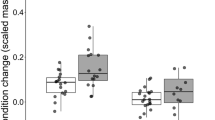Abstract
We exposed females of a highly placentotrophic viviparous scincid lizard (Pseudemoia pagenstecheri) to various environmental factors during pregnancy, and quantified the effects of these treatments on their offspring. The clear result was that the phenotypes of neonatal lizards can be substantially modified by the environment that their mother experiences during gestation. Restricting prey availability to the females reduced the size of their offspring. Limiting the females' basking opportunities delayed their seasonal timing of parturition, and modified body proportions (tail length relative to snout-vent length) of the neonates. More surprisingly, female lizards that were regularly exposed to the scent of sympatric lizard-eating snakes gave birth to offspring that were heavier, had unusually long tails relative to body length, and were highly sensitive to the odour of those snakes (as measured by tongue-flick responses). The neonates' antipredator responses were also modified by the experimental treatment to which their mother was exposed. The modifications in body mass, tail length and response to snake scent plausibly reduce the offspring's vulnerability to predatory snakes, and hence may constitute adaptive maternal manipulations of the neonatal phenotype.
Similar content being viewed by others
Author information
Authors and Affiliations
Additional information
Received: 6 July 1998 / Accepted: 5 December 1998
Rights and permissions
About this article
Cite this article
Shine, R., Downes, S. Can pregnant lizards adjust their offspring phenotypes to environmental conditions?. Oecologia 119, 1–8 (1999). https://doi.org/10.1007/s004420050754
Issue Date:
DOI: https://doi.org/10.1007/s004420050754




